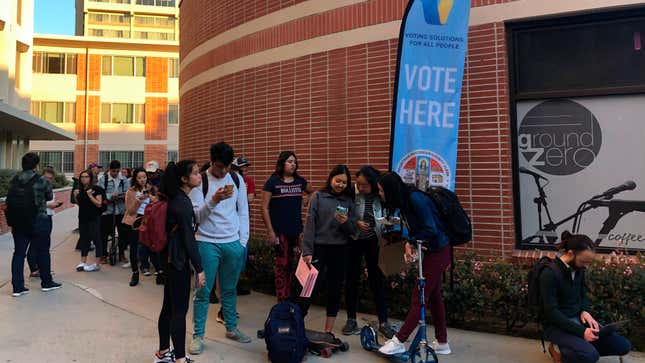
Shitty tablets helped screw up California’s March 3, 2020 primary election in big time, according to a previously unpublicized Los Angeles County report flagged by Politico on Wednesday.
Many voters had to wait hours in line to cast a vote throughout the state—with both an electronic check-in system run on KnowInk PollPads and glitchy, $300 million new Smartmatic voting machines reported to be the source of separate bottlenecks. According to Politico, the L.A. County report disputes that the new voting machines were the problem and points the finger directly at electronic poll book systems running on tablets used by poll workers.
The report only covers L.A. County, which saw turnout of over one million at over 970 polling sites, so its results may not be generalizable to the state at large. But it did find pervasive issues with the KnowInk-manufactured tablets, boding poorly for the upcoming November general election, which could potentially bust turnout records dating back to 1908. Politico wrote that the state did not seem to have circulated the report widely and it has “not previously been reported.”
Major delays were caused when poll workers, who had only synced a subset of the PollPad units with the database hosting state voter rolls during early voting, found that on Election Day the process of synchronizing the remaining units “took several hours per PollPad.” In some cases, the report states, “synchronization did not complete before the end of Election Day rendering a number of PollPad devices unusable.” Another synchronization bug forced many voters to enter provisional ballots, which are cast when the registration status of a voter cannot be confirmed. Those are often never counted.
Another massive glitch involved name searches. After a prior election, election supervisors determined that names alone were insufficient to check whether a voter was registered, as shared names were rife in the state’s database of tens of millions of voters. The PollPad software was thus updated to allow poll workers to search by street of residence and house number. Problem solved, except for the fact that just days before the election “it was discovered that the additional search fields had a significant bug which made the functionality unusable,” according to the report. So election officials had it turned off. The result was that poll workers sometimes had to sift through hundreds of names to find the correct record for any given voter.
“The lack of these additional filters made it difficult for Election Workers to find voter records and significantly slowed the Election Worker’s ability to check-in voters,” the report stated.
Finally, the app on the PollPads sucked. Poll workers “experienced the PollPad lagging screen navigation, freezes and/or crashes of the application during the PollPad synchronization on Election Day,” “significantly” slowing the voting process. Additional problems included non-operational PollPads and errors with registering conditional voters at poll sites, though the report added that “analysis from AT&T” found no evidence poor internet connections contributed to delays. Compounding all these issues was that some locations had fewer than five PollPads, bottlenecking voters even further, and that some poll locations were understaffed and lacked well-trained workers amid the ongoing coronavirus pandemic.
Other unrelated issues included a computer script that failed to mail out 17,000 vote by mail ballots to residents within the time frame mandated by law.
While some 1,297 voting machines out of 23,104 total (5.6 percent) were taken out of circulation before the election due to an issue with faulty parts that caused paper jams, the report concluded those issues didn’t contribute to delays. The authors wrote that “for the vast majority of locations, this was not the case and had minimal documented effect on wait time,” as there were more than enough operational machines in some locations. The report noted that the long lines did not extend to beyond the Kafkaesque hell of the check-in stations.
Former Lawrence Livermore National Lab computer scientist David Jefferson, an authority on voting machines, disputed that the 5.6 percent number was in any way negligible. He told Politico it was “insanely unacceptable as far as any kind of mission-critical device is concerned.”
The report said that county election officials are working with KnowInk to resolve the synchronization issue, restore address searching functionality, and increase the number of PollPads available. The county is also working on a system for voters to generate QR codes from voter records on their mobile devices to check in with a single scan.
Similar problems with KnowInk’s devices were reported as contributing to delays in Georgia in November 2019, though many of the problems were attributed to Dominion Voting Systems voting machines or inadequate training of poll workers. Attempts to modernize elections with inadequately vetted voting tech have sometimes gone wrong in some other places, most infamously in Iowa, where a buggy vote reporting app malfunctioned disastrously during the February 2020 Democratic primary caucuses.
There are efforts underway to offset some potential problems. Per the Washington Post, a joint project by the Election Assistance Commission and the Center for Internet Security is attempting to set up a system for vendors to have voting technology independently vetted for bugs and potential vulnerabilities that could be exploited by hackers. So far, KnowInk, Scytl, VR Systems, and VotingWorks are on board, though it’s unlikely that anything will be ready by November. California has also announced it will mail ballots to all eligible voters before the general election, which will hopefully offload some of the burden from voting sites across the state.